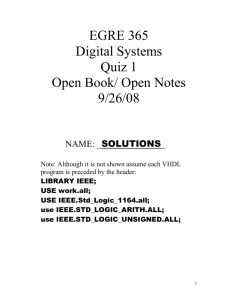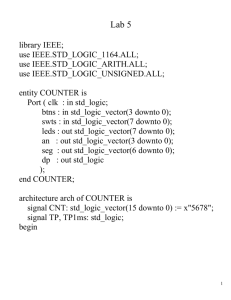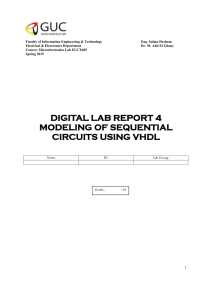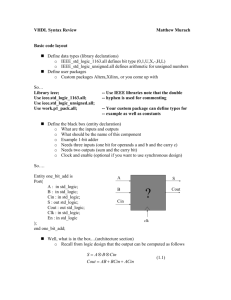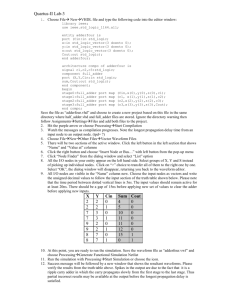Circuit Design with VHDL Problem Solutions (*)
advertisement
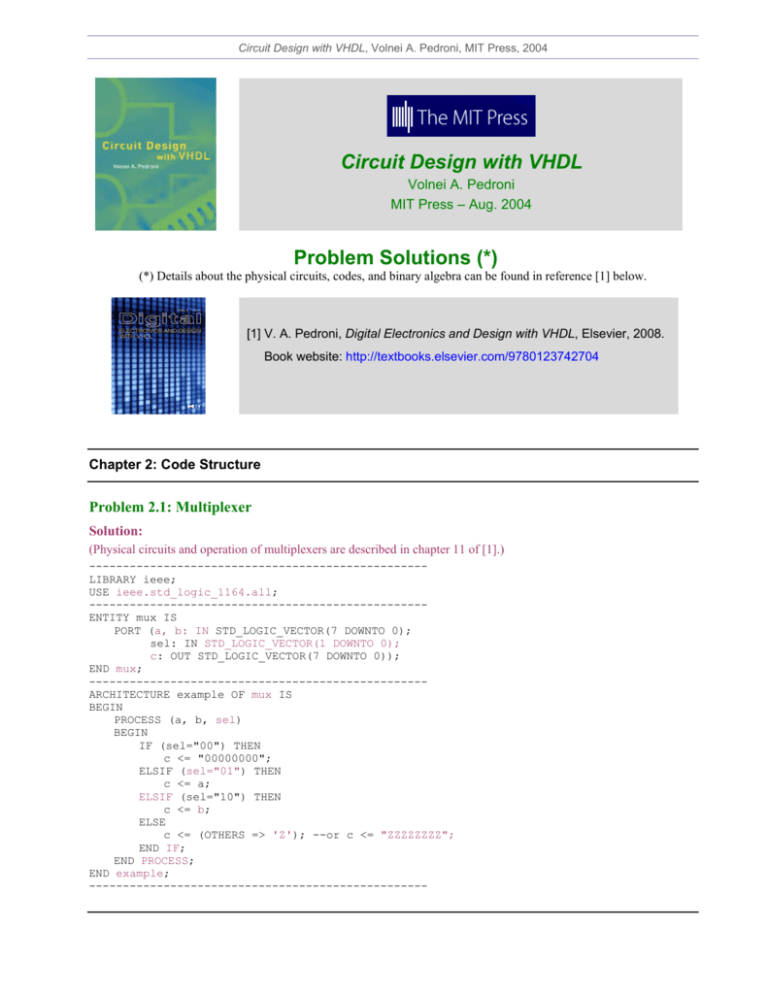
Circuit Design with VHDL, Volnei A. Pedroni, MIT Press, 2004
Circuit Design with VHDL
Volnei A. Pedroni
MIT Press – Aug. 2004
Problem Solutions (*)
(*) Details about the physical circuits, codes, and binary algebra can be found in reference [1] below.
[1] V. A. Pedroni, Digital Electronics and Design with VHDL, Elsevier, 2008.
Book website: http://textbooks.elsevier.com/9780123742704
Chapter 2: Code Structure
Problem 2.1: Multiplexer
Solution:
(Physical circuits and operation of multiplexers are described in chapter 11 of [1].)
-------------------------------------------------LIBRARY ieee;
USE ieee.std_logic_1164.all;
-------------------------------------------------ENTITY mux IS
PORT (a, b: IN STD_LOGIC_VECTOR(7 DOWNTO 0);
sel: IN STD_LOGIC_VECTOR(1 DOWNTO 0);
c: OUT STD_LOGIC_VECTOR(7 DOWNTO 0));
END mux;
-------------------------------------------------ARCHITECTURE example OF mux IS
BEGIN
PROCESS (a, b, sel)
BEGIN
IF (sel="00") THEN
c <= "00000000";
ELSIF (sel="01") THEN
c <= a;
ELSIF (sel="10") THEN
c <= b;
ELSE
c <= (OTHERS => 'Z'); --or c <= "ZZZZZZZZ";
END IF;
END PROCESS;
END example;
--------------------------------------------------
Circuit Design with VHDL, Volnei A. Pedroni, MIT Press, 2004
Chapter 3: Data Types
Problem 3.2: Dealing with data types
Solution:
0 1 0 0 0
0
1
0
0
0
1 0 0 1 0
1
0
0
1
0
1
1
0
0
1
0
1 1 0 0 1
1 1 0 0 1
Scalar
1D
1D x 1D
2D
Examples of data structures.
First, recall figure 3.1 (repeated above), which shows four types of data structures. From it, we conclude the
following for the signals listed in Problem 3.2:
a: a scalar of type BIT.
b: a scalar of type STD_LOGIC.
x: a 1D array (a vector) of type ARRAY1, whose 8 individual elements are of type STD_LOGIC.
y: a 2D array (a matrix) of type ARRAY2, whose 4x8=32 individual elements are of type STD_LOGIC.
w: a 1Dx1D array (another matrix) of type ARRAY3, whose 4 individual 8-element vectors are of type
ARRAY1.
z: another 1D array (another vector) whose 8 individual elements are again of type STD_LOGIC.
Therefore:
a <= x(2);
a: scalar, type BIT; x(2): scalar, type STD_LOGIC; assignment is illegal (type mismatch).
b <= x(2);
b: scalar, type STD_LOGIC; x(2): scalar, type STD_LOGIC; assignment is legal.
b <= y(3,5);
b: scalar, type STD_LOGIC; y(3,5): scalar, type STD_LOGIC, with valid indexing; assignment is legal.
b <= w(5)(3);
b: scalar, type STD_LOGIC; w(5,3): scalar, type STD_LOGIC, but “5” is out of bounds; assignment is
illegal.
y(1)(0) <= z(7);
y(1)(0): scalar, type STD_LOGIC, but indexing is incorrect because y is 2D (it should be y(1,0)); z(7): scalar,
type STD_LOGIC; assignment is illegal.
x(0) <= y(0,0);
x(0): scalar, type STD_LOGIC; y(0,0): scalar, type STD_LOGIC, valid indexing; assignment is legal.
x <= “1110000”;
x: 8-bit vector (1D); assignment would be legal if it contained 8 values instead of 7.
a <= “0000000”;
a is scalar (one bit), so the assignment is illegal.
y(1) <= x;
y(1): in principle, an 8-element vector, extracted from a 2D matrix, whose individual elements are of type
STD_LOGIC; however, the indexing of y is not valid, because the matrix is 2D, not 1Dx1D; x: an 8-element
vector of type ARRAY1; assignment is illegal (invalid indexing + type mismatch).
w(0) <= y;
w(0): row 0 of a 1Dx1D matrix, which is an 8-element vector of type ARRAY1; y: a 4x8 (2D) matrix;
assignment is illegal (size + type mismatches).
Circuit Design with VHDL, Volnei A. Pedroni, MIT Press, 2004
w(1) <= (7=>‘1’, OTHERS=>‘0’);
w(1): row 1 of a 1Dx1D matrix; assignment w(1)<=“10000000” is legal.
y(1) <= (0=>‘0’, OTHERS=>‘1’);
y(1): in principle, row 1 of a matrix, but the indexing is invalid, because the matrix is 2D, not 1Dx1D;
assignment y(1)<=“11111110” is illegal.
w(2)(7 DOWNTO 0) <= x;
w(2)(7 DOWNTO 0): row 2 of a 1Dx1D matrix, which is an 8-element vector of type ARRAY1; x: an 8element vector of type ARRAY1; assignment is legal.
Note: w(2)<=x would be fine too.
w(0)(7 DOWNTO 6) <= z(5 DOWNTO 4);
w(0)(7 DOWNTO 6): the leftmost 2 elements of row 0 of a 1Dx1D matrix, being each row an 8-element
vector of type ARRAY1; z(5 DOWNTO 4): 2 elements of a 8-element STD_LOGIC_VECTOR; assignment
is illegal (type mismatch).
x(3) <= x(5 DOWNTO 5);
x(3): a scalar of type STD_LOGIC; x(5 DOWNTO 5): also a scalar of type STD_LOGIC; assignment is
legal.
b <= x(5 DOWNTO 5)
b: a scalar of type STD_LOGIC; x(5 DOWNTO 5): also a scalar of type STD_LOGIC; assignment is legal.
y <= ((OTHERS=>‘0’), (OTHERS=>‘0’), (OTHERS=>‘0’), “10000001”);
y is a 2D matrix; assignment is legal.
Note: Since y is 2D, some older compilers might not accept the vector-like assignments above, thus requiring
the assignment to be made element by element (with GENERATE, for example).
The assignment below is legal too.
y <= (('0','0','0','0','0','0','0','0'),
('0','0','0','0','0','0','0','0'),
('0','0','0','0','0','0','0','0'),
('0','0','0','0','0','0','0','0'));
z(6) <= x(5);
z(6): scalar of type STD_LOGIC; x(5): also a scalar of type STD_LOGIC; assignment is legal. Notice that
though x, as a vector, is of type ARRAY1, as a scalar the “base” is STD_LOGIC.
z(6 DOWNTO 4) <= x(5 DOWNTO 3);
z(6 DOWNTO 4): 3-element vector of type STD_LOGIC_VECTOR; x(5 DOWNTO 3): 3-element vector of
type ARRAY1; assignment is illegal (type mismatch).
z(6 DOWNTO 4) <= y(5 DOWNTO 3);
The indexing of y is invalid (and the dimensions of the two spaces do not match); assignment is illegal.
y(6 DOWNTO 4) <= x(3 TO 5);
Same as above; assignment is illegal.
y(0, 7 DOWNTO 0) <= z;
y(0, 7 DOWNTO 0): in principle, row 0 of a matrix, but slicing 2D arrays is generally not supported;
assignment is illegal.
w(2,2) <= ‘1’;
w is 1Dx1D, so indexing should w(2)(2); assignment is illegal.
Problem 3.4: ROM implementation
Solution:
(Physical circuits and operation of ROM memories are described in chapter 17 of [1].)
Circuit Design with VHDL, Volnei A. Pedroni, MIT Press, 2004
Simulation results are shown after the code.
--------------------------------------------------------ENTITY rom_design IS
PORT (address: IN INTEGER RANGE 0 TO 7;
output: OUT BIT_VECTOR(3 DOWNTO 0));
END rom_design;
--------------------------------------------------------ARCHITECTURE rom_design OF rom_design IS
TYPE rom IS ARRAY (0 TO 7) OF BIT_VECTOR(3 DOWNTO 0);
CONSTANT my_rom: ROM := ("1111", --address=0, value=15
"1110", --address=1, value=14
"1101", --address=2, value=13
"1100", --address=3, value=12
"1000", --address=4, value=8
"0111", --address=5, value=7
"0110", --address=6, value=6
"0101");--address=7, value=5
BEGIN
--either of the two lines below is fine:
output <= my_rom(address);
--output <= my_rom(address)(3 DOWNTO 0);
END rom_design;
---------------------------------------------------------
Simulation results for Problem 3.4.
Chapter 4: Operators and Attributes
Problem 4.1: Operators
Solution:
x1 <= a & c; → x1 <= ”10010”;
x2 <= c & b; → x2 <= ”00101100”;
x3 <= b XOR c; → x3 <= ”1110”;
x4 <= a NOR b(3); → x4 <= ‘0’;
x5 <= b sll 2; → x5 <= ”0000”;
x6 <= b sla 2; → x6 <= ”1000”;
x7 <= b rol 2; → x7 <= ”0011”;
x8 <= a AND NOT b(0) AND NOT c(1); → x8 <= ‘0’;
d <= (5=>‘0’, OTHERS=>‘1’); → d <= “11011111”;
Problem 4.4: Generic decoder
Solution:
(Physical circuits and operation of decoders are described in chapter 11 of [1].)
-----------------------------------------------LIBRARY ieee;
USE ieee.std_logic_1164.all;
-----------------------------------------------ENTITY decoder IS
GENERIC (n: INTEGER := 8); --number of bits
PORT (ena: IN STD_LOGIC;
sel: IN INTEGER RANGE 0 TO n-1;
Circuit Design with VHDL, Volnei A. Pedroni, MIT Press, 2004
x: OUT STD_LOGIC_VECTOR(n-1 DOWNTO 0));
END decoder;
-----------------------------------------------ARCHITECTURE decoder OF decoder IS
BEGIN
PROCESS (ena, sel)
VARIABLE temp : STD_LOGIC_VECTOR (x’RANGE);
BEGIN
temp := (OTHERS => '1');
IF (ena='1') THEN
temp(sel) := '0';
END IF;
x <= temp;
END PROCESS;
END decoder;
------------------------------------------------
Chapter 5: Concurrent Code
Problem 5.1: Generic multiplexer
Solution 1: For generic n and fixed m
(Physical circuits and operation of multiplexers are described in chapter 11 of [1].)
In this solution, a PACKAGE, called my_data_types, is employed to define a new data type, called
vector_array. This data type is then used in the ENTITY of the main code to specify the inputs of the
multiplexer. Notice in the main code that the number of inputs is defined using the GENERIC statement.
---------Package:----------------------------------LIBRARY ieee;
USE ieee.std_logic_1164.all;
---------------------------------------------------PACKAGE my_data_types IS
CONSTANT m: INTEGER :=8;
TYPE vector_array IS ARRAY (NATURAL RANGE <>) OF
STD_LOGIC_VECTOR(m-1 DOWNTO 0);
END my_data_types;
------------------------------------------------------------Main code:--------------------------------LIBRARY ieee;
USE ieee.std_logic_1164.all;
USE work.my_data_types.all;
---------------------------------------------------ENTITY almost_generic_mux IS
GENERIC (number_of_inputs: INTEGER := 16);
PORT (x: IN VECTOR_ARRAY (0 TO number_of_inputs-1);
sel: IN INTEGER RANGE 0 TO number_of_inputs-1;
y: OUT STD_LOGIC_VECTOR (m-1 DOWNTO 0));
END almost_generic_mux;
---------------------------------------------------ARCHITECTURE mux OF almost_generic_mux IS
BEGIN
y <= x(sel);
END mux;
----------------------------------------------------
Solution 2: For n and m generic
---------Package:-------------------------------------------------PACKAGE my_data_types IS
TYPE matrix IS ARRAY (NATURAL RANGE <>, NATURAL RANGE <>) OF BIT;
END PACKAGE my_data_types;
-------------------------------------------------------------------
Circuit Design with VHDL, Volnei A. Pedroni, MIT Press, 2004
---------Main code:-----------------------------------------------USE work.my_data_types.all;
------------------------------------------------------------------ENTITY generic_mux IS
GENERIC (inputs: INTEGER := 16; --number of inputs
size: INTEGER := 8); --size of each input
PORT (x: IN MATRIX (0 TO inputs-1, size-1 DOWNTO 0);
sel: IN INTEGER RANGE 0 TO inputs-1;
y: OUT BIT_VECTOR (size-1 DOWNTO 0));
END generic_mux;
------------------------------------------------------------------ARCHITECTURE mux OF generic_mux IS
BEGIN
gen: FOR i IN size-1 DOWNTO 0 GENERATE
y(i) <= x(sel, i);
END GENERATE gen;
END mux;
-------------------------------------------------------------------
Problem 5.2: Priority encoder
Solution for part (a):
----------------------------------------------------ENTITY priority_encoder IS
PORT (x: IN BIT_VECTOR(7 DOWNTO 1);
y: OUT BIT_VECTOR(2 DOWNTO 0));
END priority_encoder;
----------------------------------------------------ARCHITECTURE encoder OF priority_encoder IS
BEGIN
y(2) <= x(7) OR x(6) OR x(5) OR x(4);
y(1) <= x(7) OR x(6) OR ((NOT x(5) AND NOT x(4)) AND
(x(3) OR x(2)));
y(0) <= x(7) OR (NOT x(6) AND (x(5) OR (NOT x(4) AND
(x(3) OR (NOT x(2) AND x(1))))));
END encoder;
-----------------------------------------------------
Solution for part (b):
-------------------------------------------ENTITY priority_encoder IS
PORT (x: IN BIT_VECTOR(7 DOWNTO 1);
y: OUT BIT_VECTOR(2 DOWNTO 0));
END priority_encoder;
-------------------------------------------ARCHITECTURE encoder OF priority_encoder IS
BEGIN
y <= "111" WHEN x(7)='1' ELSE
"110" WHEN x(6)='1' ELSE
"101" WHEN x(5)='1' ELSE
"100" WHEN x(4)='1' ELSE
"011" WHEN x(3)='1' ELSE
"010" WHEN x(2)='1' ELSE
"001" WHEN x(1)='1' ELSE
"000";
END encoder;
--------------------------------------------
Note: See a generic implementation in the solution of Problem 6.3.
Problem 5.4: Unsigned adder
Solution:
Circuit Design with VHDL, Volnei A. Pedroni, MIT Press, 2004
(Physical circuits and operation of adders are described in chapters 3 and 12 of [1].)
In the solution below, the inputs and outputs are considered to be of type STD_LOGIC (industry standard).
Simulation results are included after the code.
-------------------------------------------------------------------LIBRARY ieee;
USE ieee.std_logic_1164.all;
USE ieee.std_logic_signed.all; --allows arith operations w/ STD_LOGIC
-------------------------------------------------------------------ENTITY adder IS
PORT (a, b: IN STD_LOGIC_VECTOR(7 DOWNTO 0);
sum: OUT STD_LOGIC_VECTOR(7 DOWNTO 0);
cout: OUT STD_LOGIC);
END adder;
-------------------------------------------------------------------ARCHITECTURE adder OF adder IS
SIGNAL long_a, long_b, long_sum: STD_LOGIC_VECTOR(8 DOWNTO 0);
BEGIN
long_a <= '0' & a;
long_b <= '0' & b;
long_sum <= long_a + long_b;
sum <= long_sum(7 DOWNTO 0);
cout <= long_sum(8);
END adder;
--------------------------------------------------------------------
Simulation results for Problem 5.4.
Problem 5.6: Binary-to-Gray code converter
Solution:
(Gray code is described in chapter 2 of [1].)
The figure below shows two approaches to solve this problem. In (a), a circuit is used to generate the Gray
code corresponding to the (conventional) binary word presented at its input. In (b), a ROM (Read-Only
Memory), similar to that seen in Problem 3.4, is used, in which the input acts as the address and the output is
the ROM’s content at that address.
input
(binary)
Gray-code
generator
output
(gray)
input
(binary)
ROM
output
(gray)
(a)
(b)
Two approaches to attain a binary-to-Gray converter.
Since the problem asks for a generic solution (that is, for any number of bits, N), approach (a) will be
employed. The Gray word, g(N−1:0), corresponding to a regular binary word, b(N−1:0), can be obtained in
several ways, among them the following:
g(N−1:0) = b(N−1:0) XOR (b(N−1:0) SRL 1)
Or, equivalently:
Circuit Design with VHDL, Volnei A. Pedroni, MIT Press, 2004
g(N−1:0) = b(N−1:0) XOR (‘0’ & b(N−1:1))
Or yet:
g(N−1) = b(N−1)
g(N−2:0) = b(N−2:0) XOR b(N−1:1)
A corresponding, generic VHDL code is presented below, followed by simulation results for N=4.
Note: See the question for the reader at the end of this exercise.
----------------------------------------------------LIBRARY ieee;
USE ieee.std_logic_1164.all;
----------------------------------------------------ENTITY gray_encoder IS
GENERIC (N: INTEGER := 4);
PORT (input: IN STD_LOGIC_VECTOR(N-1 DOWNTO 0);
output: OUT STD_LOGIC_VECTOR(N-1 DOWNTO 0));
END gray_encoder;
----------------------------------------------------ARCHITECTURE gray_encoder OF gray_encoder IS
BEGIN
output(N-1) <= input(N-1);
output(N-2 DOWNTO 0) <= input(N-2 DOWNTO 0) XOR input(N-1 DOWNTO 1);
END gray_encoder;
-----------------------------------------------------
Simulation results for Problem 5.6.
Question regarding the solution above: Three equivalent equations were presented to calculate Gray words
from (regular) binary words. However, from a VHDL perspective, the first equation (that with the shift-right
logic operator, SRL) is inferior to the others. Explain why. (Suggestion: Check in the package standard
which data types are supported by the shift operators.)
Problem 5.8: Signed/unsigned comparator
Solution:
(Physical circuits and operation of comparators are described in chapter 12 of [1].)
In the code below, the package std_logic_arith was used because it contains the conversion function
CONV_SIGNED as well as respective comparison operators. Note in the simulation results that the numbers
are always non-negative while sel=‘0’, but are signed for sel=‘1’ (so, for example, 150 is indeed −106). The
glitches at some of the state transitions are absolutely normal.
------------------------------------------------LIBRARY ieee;
USE ieee.std_logic_1164.all;
USE ieee.std_logic_arith.all;
------------------------------------------------ENTITY comparator IS
PORT (a, b: IN INTEGER RANGE 0 TO 255;
sel: IN STD_LOGIC;
x1, x2, x3: OUT STD_LOGIC);
END comparator;
------------------------------------------------ARCHITECTURE comparator OF comparator IS
Circuit Design with VHDL, Volnei A. Pedroni, MIT Press, 2004
SIGNAL a_signed, b_signed: SIGNED(7 DOWNTO 0);
SIGNAL temp: STD_LOGIC_VECTOR(1 TO 4);
BEGIN
a_signed <= CONV_SIGNED(a, 8);
b_signed <= CONV_SIGNED(b, 8);
temp(1) <= '1' WHEN a>b ELSE
'0';
temp(2) <= '1' WHEN a=b ELSE
'0';
temp(3) <= '1' WHEN a_signed>b_signed ELSE
'0';
temp(4) <= '1' WHEN a_signed=b_signed ELSE
'0';
x1 <= temp(1) WHEN sel='0' ELSE
temp(3);
x2 <= temp(2) WHEN sel='0' ELSE
temp(4);
x3 <= NOT(temp(1) OR temp(2)) WHEN sel='0' ELSE
NOT(temp(2) OR temp(3));
END comparator;
-------------------------------------------------
Simulation results for Problem 5.8.
Chapter 6: Sequential Code
Problem 6.3: Priority encoder
Solution 1: Non-generic
Two solutions are presented for part(a). Solution 1 is explicit (“brute force”), while solution 2 is generic. The
latter is obviously recommended. Simulation results are also included.
--------------------------------------------ENTITY priority_encoder IS
PORT (x: IN BIT_VECTOR(7 DOWNTO 1);
y: OUT BIT_VECTOR(2 DOWNTO 0));
END priority_encoder;
--------------------------------------------ARCHITECTURE encoder OF priority_encoder IS
BEGIN
PROCESS(x)
BEGIN
IF (x(7)='1') THEN
y <= "111";
ELSIF (x(6)='1') THEN
y <= "110";
ELSIF (x(5)='1') THEN
y <= "101";
ELSIF (x(4)='1') THEN
y <= "100";
ELSIF (x(3)='1') THEN
y <= "011";
ELSIF (x(2)='1') THEN
Circuit Design with VHDL, Volnei A. Pedroni, MIT Press, 2004
y <= "010";
ELSIF (x(1)='1') THEN
y <= "001";
ELSE
y <= "000";
END IF;
END PROCESS;
END encoder;
---------------------------------------------
Solution 2: Generic
----------------------------------------------------ENTITY priority_encoder IS
GENERIC (N: INTEGER := 3); --number of output bits
PORT (x: IN BIT_VECTOR(2**N-1 DOWNTO 1);
y: OUT INTEGER RANGE 0 TO 2**N-1);
END priority_encoder;
----------------------------------------------------ARCHITECTURE priority_encoder OF priority_encoder IS
BEGIN
PROCESS(x)
VARIABLE temp: INTEGER RANGE 0 TO 2**N-1;
BEGIN
temp := 0;
FOR i IN x'RANGE LOOP
IF (x(i)='1') THEN
temp := i;
EXIT;
END IF;
END LOOP;
y <= temp;
END PROCESS;
END priority_encoder;
-----------------------------------------------------
Simulation results for Problem 6.3.
Problem 6.4: Generic frequency divider
Solution:
(Physical circuits and operation of frequency dividers are described in chapters 14 and 15 of [1].)
----Clock frequency is divided by n----------LIBRARY ieee;
USE ieee.std_logic_1164.all;
---------------------------------------------ENTITY clock_divider IS
GENERIC (n: INTEGER := 7);
PORT (clkin: IN STD_LOGIC;
clkout: OUT STD_LOGIC);
END clock_divider;
---------------------------------------------ARCHITECTURE clock_divider OF clock_divider IS
BEGIN
PROCESS (clkin)
VARIABLE count: INTEGER RANGE 0 TO n;
BEGIN
IF (clkin'EVENT AND clkin='1') THEN
Circuit Design with VHDL, Volnei A. Pedroni, MIT Press, 2004
count := count + 1;
IF (count=n/2) THEN
clkout <= '1';
ELSIF (count=n) THEN
clkout <= '0';
count := 0;
END IF;
END IF;
END PROCESS;
END clock_divider;
----------------------------------------------
Simulation results for Problem 6.4.
Problem 6.6: Timer #1
Solution:
(Physical circuits and operation of timers are described in chapter 14 of [1].)
In the code below, the problem was modified slightly:
i) The start and stop inputs where replaced with a single control signal, called run, which causes the circuit to
count when run=‘1’ (given that 9:59 has not been reached yet) or keep its last state when run=‘0’.
ii) The clock frequency was entered using the GENERIC attribute, so the circuit can be easily adjusted to any
clock frequency.
The SSDs (seven-segment displays) where considered to be common cathode (positive logic), with the
segments represented by abcdefgx, where x is the SSD’s decimal point (kept off in the digits of seconds and
on in the digit of minutes).
A little portion of the experimental results is included after the code below.
----------------------------------------------------------------LIBRARY ieee;
USE ieee.std_logic_1164.all;
----------------------------------------------------------------ENTITY timer1 IS
GENERIC (fclk: INTEGER := 5); --clock frequency in Hz
PORT (clk, rst, run: IN STD_LOGIC;
digit1, digit2, digit3: OUT STD_LOGIC_VECTOR(7 DOWNTO 0));
END timer1;
----------------------------------------------------------------ARCHITECTURE timer1 OF timer1 IS
SIGNAL oneHz_clk: STD_LOGIC;
SIGNAL seconds1: INTEGER RANGE 0 TO 10; --units of seconds
SIGNAL seconds2: INTEGER RANGE 0 TO 6; --tens of seconds
SIGNAL minutes: INTEGER RANGE 0 TO 10; --units of minutes
BEGIN
----1Hz clock:---------------------------------PROCESS (clk)
VARIABLE count: INTEGER RANGE 0 TO fclk;
BEGIN
IF (clk'EVENT AND clk='1') THEN
count := count + 1;
IF (count=fclk/2) THEN
oneHz_clk <= '1';
ELSIF (count=fclk) THEN
oneHz_clk <= '0';
Circuit Design with VHDL, Volnei A. Pedroni, MIT Press, 2004
count := 0;
END IF;
END IF;
END PROCESS;
----BCD counters:------------------------------PROCESS (oneHz_clk, rst)
VARIABLE count1: INTEGER RANGE 0 TO 10; --units of seconds
VARIABLE count2: INTEGER RANGE 0 TO 6; --tens of seconds
VARIABLE count3: INTEGER RANGE 0 TO 10; --units of minutes
BEGIN
IF (rst='1') THEN
count1:=0;
count2:=0;
count3:=0;
ELSIF (clk'EVENT AND clk='1') THEN
IF (run='1' AND (count1/=9 OR count2/=5 OR count3/=9)) THEN
count1 := count1 + 1;
IF (count1=10) THEN
count1 := 0;
count2 := count2 + 1;
IF (count2=6) THEN
count2 := 0;
count3 := count3 + 1;
END IF;
END IF;
END IF;
END IF;
seconds1 <= count1;
seconds2 <= count2;
minutes <= count3;
END PROCESS;
---Conversion from BCD to SSD:----------------PROCESS (seconds1, seconds2, minutes)
BEGIN
CASE seconds1 IS
WHEN 0 => digit1 <= "11111100"; --decimal 252
WHEN 1 => digit1 <= "01100000"; --decimal 96
WHEN 2 => digit1 <= "11011010"; --decimal 218
WHEN 3 => digit1 <= "11110010"; --decimal 242
WHEN 4 => digit1 <= "01100110"; --decimal 102
WHEN 5 => digit1 <= "10110110"; --decimal 182
WHEN 6 => digit1 <= "10111110"; --decimal 190
WHEN 7 => digit1 <= "11100000"; --decimal 224
WHEN 8 => digit1 <= "11111110"; --decimal 254
WHEN 9 => digit1 <= "11110110"; --decimal 246
WHEN OTHERS => NULL;
END CASE;
CASE seconds2 IS
WHEN 0 => digit2 <= "11111100"; --decimal 252
WHEN 1 => digit2 <= "01100000"; --decimal 96
WHEN 2 => digit2 <= "11011010"; --decimal 218
WHEN 3 => digit2 <= "11110010"; --decimal 242
WHEN 4 => digit2 <= "01100110"; --decimal 102
WHEN 5 => digit2 <= "10110110"; --decimal 182
WHEN OTHERS => NULL;
END CASE;
CASE minutes IS
WHEN 0 => digit3 <= "11111101"; --decimal 253
WHEN 1 => digit3 <= "01100001"; --decimal 97
WHEN 2 => digit3 <= "11011011"; --decimal 219
WHEN 3 => digit3 <= "11110011"; --decimal 243
WHEN 4 => digit3 <= "01100111"; --decimal 103
WHEN 5 => digit3 <= "10110111"; --decimal 183
WHEN 6 => digit3 <= "10111111"; --decimal 192
WHEN 7 => digit3 <= "11100001"; --decimal 225
WHEN 8 => digit3 <= "11111111"; --decimal 255
Circuit Design with VHDL, Volnei A. Pedroni, MIT Press, 2004
WHEN 9 => digit3 <= "11110111"; --decimal 247
WHEN OTHERS => NULL;
END CASE;
END PROCESS;
END timer1;
-----------------------------------------------------------------
Simulation results for Problem 6.6.
Problem 6.8: Parity detector
Solution:
(Physical circuits and operation of parity detectors are described in chapter 11 of [1].)
The solution below, using sequential code, is fine for any number of bits (N). Simulation results are also
presented.
-------------------------------------------------LIBRARY ieee;
USE ieee.std_logic_1164.all;
-------------------------------------------------ENTITY parity_detector IS
GENERIC (N: INTEGER := 8); --number of bits
PORT (input: IN STD_LOGIC_VECTOR(N-1 DOWNTO 0);
output: OUT STD_LOGIC);
END parity_detector;
-------------------------------------------------ARCHITECTURE parity_detector OF parity_detector IS
BEGIN
PROCESS (input)
VARIABLE temp: STD_LOGIC_VECTOR(N-1 DOWNTO 0);
BEGIN
temp(0) := input(0);
FOR i IN 1 TO N-1 LOOP
temp(i) := input(i) XOR temp(i-1);
END LOOP;
output <= temp(N-1);
END PROCESS;
END parity_detector;
--------------------------------------------------
Simulation results for Problem 6.8.
Problem 6.16: Carry-ripple adder
Solution:
Circuit Design with VHDL, Volnei A. Pedroni, MIT Press, 2004
(Physical circuits and operation of adders are described in chapters 3 and 12 of [1].)
Part (a): Because of type mismatch (temp is INTEGER, c0 is STD_LOGIC).
Part (b): See the code below.
----------------------------------------------------LIBRARY ieee;
USE ieee.std_logic_1164.all;
----------------------------------------------------ENTITY carry_ripple_adder IS
GENERIC (length: INTEGER := 8);
PORT (a, b: IN STD_LOGIC_VECTOR(length-1 DOWNTO 0);
cin: IN STD_LOGIC;
s: OUT STD_LOGIC_VECTOR(length-1 DOWNTO 0);
cout: OUT STD_LOGIC);
END carry_ripple_adder;
----------------------------------------------------ARCHITECTURE adder OF carry_ripple_adder IS
SIGNAL carry: STD_LOGIC_VECTOR(length DOWNTO 0);
BEGIN
carry(0) <= cin;
generate_output: FOR i IN 0 TO length-1 GENERATE
s(i) <= a(i) XOR b(i) XOR carry(i);
carry(i+1) := (a(i) AND b(i)) OR (a(i) AND
carry(i)) OR (b(i) AND carry(i));
END GENERATE;
cout <= carry(length);
END adder;
-----------------------------------------------------
Problem 6.17: DFF
Solution:
(Physical circuits and operation of all types of flip-flops are described in chapter 13 of [1].)
Architecture 1: A truly D-type flip-flop with asynchronous reset (same as in Example 6.1) .
Architecture 2: Only the clock appears in the sensitivity list, causing the reset to be synchronous.
Architecture 3: clk’EVENT is not associated with a test (AND clk=‘1’, for example). Some compilers might
assume a default test (AND clk=‘1’), while others will simply halt. Consequently, to avoid mistakes,
explicitly writing the test is advisable.
Architecture 4: Here the contents of sections 6.10 and 7.5 are helpful. Notice that no signal assignment is
made at the transition of another signal, signifying that, in principle, no flip-flop is wanted (probably a
combinational circuit). However, only one of the input signals appears in the sensitivity list, and an
incomplete truth table for q is specified in the code, causing the inference of a latch to hold q’s value (a
“pseudo” combinational circuit.
Architecture 5: The situation here is even more awkward than that above. Besides generating again a latch,
the value of d also causes the process to be run. The result is a circuit very unlikely to be of any interest.
Chapter 7: Signals and Variable
Problem 7.2: Data delay
Solution:
(Physical circuits and operation of data delays using shift registers are described in chapter 14 of [1].)
---------------------------------------------
Circuit Design with VHDL, Volnei A. Pedroni, MIT Press, 2004
LIBRARY ieee;
USE ieee.std_logic_1164.all;
--------------------------------------------ENTITY data_delay IS
PORT (d: IN STD_LOGIC_VECTOR(7 DOWNTO 0);
clk: IN STD_LOGIC;
sel: IN INTEGER RANGE 0 TO 3;
q: OUT STD_LOGIC_VECTOR(7 DOWNTO 0));
END data_delay;
--------------------------------------------ARCHITECTURE data_delay OF data_delay IS
TYPE register_array IS ARRAY (0 TO 3) OF
STD_LOGIC_VECTOR(7 DOWNTO 0);
SIGNAL internal: register_array;
BEGIN
PROCESS (clk, sel)
BEGIN
IF (clk'EVENT AND clk='1') THEN
internal <= d & internal(0 TO 2);
END IF;
END PROCESS;
q <= internal(sel);
END data_delay;
---------------------------------------------
Simulation results for Problem 7.2.
Problem 7.6: Generic address decoder
Solution:
(Physical circuits and operation of decoders are described in chapter 11 of [1].)
------------------------------------------------------LIBRARY ieee;
USE ieee.std_logic_1164.all;
------------------------------------------------------ENTITY address_decoder IS
GENERIC (N: INTEGER := 8); --#number of output bits
PORT (ena: IN STD_LOGIC;
address: IN INTEGER RANGE 0 TO N-1;
x: OUT STD_LOGIC_VECTOR(N-1 DOWNTO 0));
END address_decoder;
------------------------------------------------------ARCHITECTURE behavior OF address_decoder IS
BEGIN
PROCESS (ena, address)
VARIABLE temp: STD_LOGIC_VECTOR(x'RANGE);
BEGIN
temp := (OTHERS => '1');
IF (ena='1') THEN
temp(address) := '0';
END IF;
Circuit Design with VHDL, Volnei A. Pedroni, MIT Press, 2004
x <= temp;
END PROCESS;
END behavior;
-------------------------------------------------------
Simulation results for Problem 7.6.
Chapter 8: State Machines
Problem 8.2: Signal generator #1
Solution:
(Physical circuits, design, and operation of finite state machines are described in chapter 15 of [1]. The solution that
follows is based on the arbitrary signal generator design technique introduced there. The corresponding signals are
depicted in the figure below.)
clk
clk
out1
Signal
generator
desired
output
out2
states of FSM1
0
‘1’
1
clk
2
sel1
FSM1
sel1 (output of FSM1)
Glitch
remover
x
‘1’
1
B
C
D
1
2
1
0
‘1’
clk’
‘1’
‘0’
machine 1
x (output of MUX1)
0
MUX2
‘0’
MUX1
Waveform
generator
A
sel2
y
states of FSM2
sel2 (output of FSM2)
FSM2
A
B
C
1
2
1
x
‘1’
x
D
0
machine 2
x
y (output of MUX2)
T
Details regarding the states machines of Problem 8.2.
In this exercise, out1 is very simple to generate, because all of its transitions are at the same clock edge
(positive). However, the same is not true for out2, which contains transitions at both clock edges.
Consequently, for the latter, the technique introduced in [1] is very helpful (indeed, the “weirder” the signal
to be generated, the more useful that approach is). Coincidently, the shape of out2 in this exercise is not
subject to glitches during signal construction, so to better illustrate the use of such that technique a slight
modification will be introduced (see the waveform right below clk in the figure above). Observe that now x is
subject to glitches, making the problem a more general case.
Two FSMs are employed to create the desired signal, each associated with a multiplexer. The pair FSM1MUX1 is responsible for generating the signal (possibly with glitches), while the pair FSM2-MUX2 is
responsible for cleaning it (recall that in a signal generator glitches are never acceptable). As shown in the
figure, FSM1 operates at the positive clock edge, while FSM2 operates at the negative transition. The states
(for both machines) are called A, B, C, and D.
A corresponding VHDL code is shown below, followed by simulation results. Observe in the latter the
expected glitches in x, which disappear in y.
Circuit Design with VHDL, Volnei A. Pedroni, MIT Press, 2004
----------------------------------------------------ENTITY signal_generator IS
PORT (clk: IN BIT;
x: BUFFER BIT;
y: OUT BIT);
END signal_generator;
----------------------------------------------------ARCHITECTURE signal_generator OF signal_generator IS
TYPE state IS (A, B, C, D);
SIGNAL pr_state1, nx_state1: state;
SIGNAL pr_state2, nx_state2: state;
ATTRIBUTE enum_encoding: STRING;
ATTRIBUTE enum_encoding OF state: TYPE IS "sequential";
BEGIN
----- Lower section of FSM1: ----PROCESS (clk)
BEGIN
IF (clk'EVENT AND clk='1') THEN
pr_state1 <= nx_state1;
END IF;
END PROCESS;
----- Upper section of FSM1: ----PROCESS (pr_state1, clk)
BEGIN
CASE pr_state1 IS
WHEN A =>
x <= '1';
nx_state1 <= B;
WHEN B =>
x <= NOT clk;
nx_state1 <= C;
WHEN C =>
x <= '1';
nx_state1 <= D;
WHEN D =>
x <= '0';
nx_state1 <= A;
END CASE;
END PROCESS;
----- Lower section of FSM2: ----PROCESS (clk)
BEGIN
IF (clk'EVENT AND clk='0') THEN
pr_state2 <= nx_state2;
END IF;
END PROCESS;
----- Upper section of FSM2: ----PROCESS (pr_state1, pr_state2, x)
BEGIN
nx_state2 <= pr_state1; --synchronism
CASE pr_state2 IS
WHEN A =>
y <= x;
WHEN B =>
y <= '1';
WHEN C =>
y <= x;
WHEN D =>
y <= x;
END CASE;
END PROCESS;
END signal_generator;
-----------------------------------------------------
Circuit Design with VHDL, Volnei A. Pedroni, MIT Press, 2004
Simulation results for Problem 8.2.
Problem 8.6: Signal generator of Problem 8.2 without FSM approach
Solution:
(Physical circuits, design, and operation of sequential circuits are described in chapter 14 of [1]. The solution that
follows is based on the theory presented there. The corresponding signals are depicted in the figure below.)
clk
counter
0
1
2
3
a
clk
Signal
generator
out1
auxiliary
signals
b
c
out2
output
signals
out1
out2
T
Signals employed in the solution of Problem 8.6.
In this case (see figure above), three auxiliary signals (a, b, c) are created, from which out1 and out2 are then
derived using conventional gates. As described in chapter 14 of [1], the fundamental point here is to
guarantee that the outputs are not prone to glitches. To guarantee glitch-free outputs, all three auxiliary
signals are registered (i.e., stored in DFFs); consequently, given that no two signals that affect the gates’
outputs change at the same clock edge, glitch-free outputs are automatically generated. A corresponding
VHDL follows, along with simulation results.
---------------------------------------------------ENTITY signal_generator IS
PORT (clk: IN BIT;
out1, out2: OUT BIT);
END signal_generator;
---------------------------------------------------ARCHITECTURE signal_generator OF signal_generator IS
SIGNAL a, b, c: BIT;
SIGNAL counter: INTEGER RANGE 0 TO 3;
BEGIN
----Creating a counter:-----------PROCESS (clk)
VARIABLE count: INTEGER RANGE 0 TO 4;
BEGIN
IF (clk'EVENT AND clk='1') THEN
count := count + 1;
IF (count=4) THEN
count := 0;
END IF;
END IF;
counter <= count;
END PROCESS;
----Generating signal a:----------PROCESS (clk)
Circuit Design with VHDL, Volnei A. Pedroni, MIT Press, 2004
BEGIN
IF (clk'EVENT AND clk='1') THEN
IF (counter=0) THEN
a <= '1';
ELSE
a <= '0';
END IF;
END IF;
END PROCESS;
----Generating signal b:----------PROCESS (clk)
BEGIN
IF (clk'EVENT AND clk='0') THEN
IF (counter=1) THEN
b <= '1';
ELSE
b <= '0';
END IF;
END IF;
END PROCESS;
----Generating signal c:----------PROCESS (clk)
BEGIN
IF (clk'EVENT AND clk='1') THEN
IF (counter=3) THEN
c <= '1';
ELSE
c <= '0';
END IF;
END IF;
END PROCESS;
----Generating the outputs:-------out1 <= c;
out2 <= (a AND b) OR c;
END signal_generator;
----------------------------------------------------
Simulation results for Problem 8.6.
Chapter 9: Additional Circuit Designs
Problem 9.5: Serial data transmitter
Solution:
A typical way of solving this kind of problem is to store the data vector into a shift register (when the data is
ready, of course) and then shift the values out sequentially. The general data structure is then that shown in
the figure below. Note that the overall protocol has been modified slightly to resemble an actual SPC (Single
Parity Check) code, similar, for example, to that used in PS/2 computer keyboards (see chapter 7 of [1]). A
corresponding VHDL code is shown below, followed by simulation results.
Circuit Design with VHDL, Volnei A. Pedroni, MIT Press, 2004
(LSB)
start=‘0’
d(0)
(MSB)
d(1)
d(2)
d(3)
d(4)
d(5)
d(6)
d(7)
parity
stop=‘1’
data
stop=‘1’
11
parity
d(7)
10
9
d(6)
d(5)
8
7
d(4)
6
d(3)
5
d(2)
d(1)
4
3
d(0)
2
start=‘0’
1
data_out
clk
Data structure for Problem 9.5.
------------------------------------------------------------------------ENTITY serial_tx IS
PORT (clk: IN BIT;
data_ready: IN BOOLEAN;
data: IN BIT_VECTOR(7 DOWNTO 0);
data_out: OUT BIT);
END serial_tx;
------------------------------------------------------------------------ARCHITECTURE serial_tx OF serial_tx IS
SIGNAL shift_register: BIT_VECTOR(11 DOWNTO 1) := (OTHERS=>'1');
SIGNAL parity: BIT;
BEGIN
----Determining parity bit (see Problem 6.8):------------PROCESS (data)
VARIABLE temp: BIT_VECTOR(7 DOWNTO 0);
BEGIN
temp(0) := data(0);
FOR i IN 1 TO 7 LOOP
temp(i) := data(i) XOR temp(i-1);
END LOOP;
parity <= temp(7);
END PROCESS;
----Creating shift register and transmitting data:-------PROCESS (clk)
VARIABLE count: INTEGER RANGE 0 TO 12 := 0;
VARIABLE flag: BIT;
BEGIN
IF (clk'EVENT AND clk='1') THEN
IF (data_ready AND flag='0') THEN
flag := '1';
count := count + 1;
shift_register <= ('1' & parity & data(7 DOWNTO 0) & '0');
ELSIF (flag='1') THEN
shift_register <= ('0' & shift_register(11 DOWNTO 2));
count := count + 1;
IF (count=11) THEN
count := 0;
flag := '0';
END IF;
END IF;
END IF;
data_out <= shift_register(1);
END PROCESS;
END serial_tx;
-------------------------------------------------------------------------
Circuit Design with VHDL, Volnei A. Pedroni, MIT Press, 2004
Simulation results for Problem 9.5.
Chapter 10: Packages and Components
Problem 10.2: Carry-ripple adder constructed with components
Solution:
A VHDL code for this exercise is shown below. Further details, including its physical implementation and
other adder architectures can be seen in [1] (chapters 12, 19, and 232).
---------The component (full-adder unit):-------ENTITY FAU IS
PORT (a, b, cin: IN BIT;
s, cout: OUT BIT);
END FAU;
------------------------------------------------ARCHITECTURE full_adder OF FAU IS
BEGIN
s <= a XOR b XOR cin;
cout <= (a AND b) OR (a AND cin) OR (b AND cin);
END full_adder;
---------------------------------------------------------Main code:----------------------------------------ENTITY carry_ripple_adder IS
GENERIC (N : INTEGER := 8); --number of bits
PORT (a, b: IN BIT_VECTOR(N-1 DOWNTO 0);
cin: IN BIT;
s: OUT BIT_VECTOR(N-1 DOWNTO 0);
cout: OUT BIT);
END carry_ripple_adder;
------------------------------------------------------------ARCHITECTURE structural OF carry_ripple_adder IS
SIGNAL carry: BIT_VECTOR(N DOWNTO 0);
--------------------------------------------COMPONENT FAU IS
PORT (a, b, cin: IN BIT; s, cout: OUT BIT);
END COMPONENT;
--------------------------------------------BEGIN
carry(0) <= cin;
generate_adder: FOR i IN a'RANGE GENERATE
adder: FAU PORT MAP (a(i), b(i), carry(i), s(i), carry(i+1));
END GENERATE;
cout <= carry(N);
END structural;
-------------------------------------------------------------
Chapter 11: Functions and Procedures
Circuit Design with VHDL, Volnei A. Pedroni, MIT Press, 2004
Problem 11.1: Conversion to STD_LOGIC_VECTOR
Solution:
A VHDL code for this exercise is shown below. To test it, just a jumper from the input to the output was
used, in which case the compiler must give equations of the type output(i)=input(i), for i=0, 1, …, N-1. A
similar function can be found in the standard package std_logic_arith, available in the library of your VHDL
synthesis software. Note that in the solution below the function was located in the main code; to install it in a
package, just follow the instruction in chapter 11 (see example 11.4, for example).
------------------------------------------------------LIBRARY ieee;
USE ieee.std_logic_1164.all;
------------------------------------------------------ENTITY data_converter IS
GENERIC (N: INTEGER := 4); --number of bits
PORT (input: IN INTEGER RANGE 0 TO 2**N-1;
output: OUT STD_LOGIC_VECTOR(N-1 DOWNTO 0));
END data_converter;
------------------------------------------------------ARCHITECTURE data_converter OF data_converter IS
SIGNAL x: STD_LOGIC_VECTOR(N-1 DOWNTO 0);
FUNCTION conv_std_logic(arg: INTEGER; size: INTEGER)
RETURN STD_LOGIC_VECTOR IS
VARIABLE temp: INTEGER RANGE 0 TO 2**size-1;
VARIABLE result: STD_LOGIC_VECTOR(size-1 DOWNTO 0);
BEGIN
temp := arg;
FOR i IN result'RANGE LOOP
IF (temp>=2**i) THEN
result(i) := '1';
temp := temp - 2**i;
ELSE
result(i) := '0';
END IF;
END LOOP;
RETURN result;
END conv_std_logic;
BEGIN
output <= conv_std_logic(input, N);
END data_converter;
-------------------------------------------------------
Chapter 12: Additional System Designs
Problem 12.4: General-purpose FIR filter
Solution:
A block diagram for this circuit is shown below. It contains two shift registers, which store the input values
(x) and the filter coefficients (c). It contains also a register to store the accumulated (acc) value, producing the
filter output (y). The total number of taps is n, with m bits used to represent x and c, and 2m bits for the aftermultiplication paths. Hence a total of 2nm+m flip-flops are required. Observe that the taps are all alike, so
COMPONENT can be used to easily implement this circuit. A slightly more difficult (non-structural) solution
is shown below; the structural option (with COMPONENT) is left to the reader. Note that the code includes
overflow check. Simulation results are also included.
Circuit Design with VHDL, Volnei A. Pedroni, MIT Press, 2004
tap1
x_input
c_input
x1
c1
tap2
x2
c2
tap3
x3
c3
tapn
xn
m bits
2m bits
cn
acc
y
y
Circuit diagram for Problem 12.4.
----------------------------------------------------------------LIBRARY ieee;
USE ieee.std_logic_1164.all;
USE ieee.std_logic_arith.all; --package needed for SIGNED
----------------------------------------------------------------ENTITY FIR IS
GENERIC (n: INTEGER := 4; --number of coefficients
m: INTEGER := 4); --number of bits per coefficient
PORT (clk, rst: IN STD_LOGIC;
load: STD_LOGIC; --to enter new coefficient values
run: STD_LOGIC; --to compute the output
x_input, coef_input: IN SIGNED(m-1 DOWNTO 0);
y: OUT SIGNED(2*m-1 DOWNTO 0);
overflow: OUT STD_LOGIC);
END FIR;
----------------------------------------------------------------ARCHITECTURE FIR OF FIR IS
TYPE internal_array IS ARRAY (1 TO n) OF SIGNED(m-1 DOWNTO 0);
SIGNAL c: internal_array;
--stored coefficients
SIGNAL x: internal_array;
--stored input values
BEGIN
PROCESS (clk, rst)
VARIABLE prod, acc: SIGNED(2*m-1 DOWNTO 0) := (OTHERS=>'0');
VARIABLE sign_prod, sign_acc: STD_LOGIC;
BEGIN
-----Reset:---------------------------------IF (rst='1') THEN
FOR i IN 1 TO n LOOP
FOR j IN m-1 DOWNTO 0 LOOP
x(i)(j) <= '0';
END LOOP;
END LOOP;
-----Shift registers:-----------------------ELSIF (clk'EVENT AND clk='1') THEN
IF (load='1') THEN
c <= (coef_input & c(1 TO n-1));
ELSIF (run='1') THEN
x <= (x_input & x(1 TO n-1));
END IF;
END IF;
-----MACs and output (w/ overflow check):---acc := (OTHERS=>'0');
FOR i IN 1 TO n LOOP
prod := x(i)*c(i);
sign_prod := prod(2*m-1);
sign_acc := acc(2*m-1);
acc := prod + acc;
IF (sign_prod=sign_acc AND acc(2*m-1)/=sign_acc) THEN
overflow <= '1';
ELSE
overflow <= '0';
END IF;
Circuit Design with VHDL, Volnei A. Pedroni, MIT Press, 2004
END LOOP;
IF (clk'EVENT AND clk='1') THEN
y <= acc;
END IF;
END PROCESS;
END FIR;
-----------------------------------------------------------------
Simulation results for Problem 12.4.

